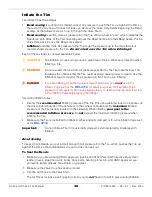
DT-50 and DT-50A Tire Changer
36
P/N 5900260 — Rev. A1 — Dec. 2020
•
When mounting a Tire
. Put the TPMS sensor just to the
left
of the Mount/Demount Head.
These are general guidelines. Use common sense and take into consideration the specifics of each
situation. Talk to your Supervisor if you are still unsure.
When completing a Tire mounting with a TPMS sensor, check that it is working. It is against the law to
knowingly re-install a non-functional TPMS. If the Vehicle came in with a functioning TPMS, it needs to
leave with a functioning TPMS.
The Steps in Changing a Tire
Before you start working on a Tire, review the requirements in
Changing a Tire consists of multiple steps:
Deflate the Tire
.
There is a lot of energy stored in a Tire when it is inflated. You
must
fully
deflate the Tire before you can demount it. If you do not, that energy will be released when you try
to demount it, which could result in the Tire exploding, causing injury and even death to the
Operator or bystanders.
Never work on a Tire unless you have personally confirmed
that it is fully deflated
. The best way to do this is to make sure the Valve Core has been
removed from the Valve Stem and the air has had time to come out.
Break the Bead
.
Tires stay in position on the Wheel because the Tire Bead is seated between
the Bead Retainer and the Rim Lip of the Wheel (called the Bead Seat). To demount a Tire, you
must get the Bead out of the Bead Seat all the way around
both sides
of the Tire. This is called
Breaking the Bead. Use care when Breaking the Bead of Wheels with a Tire Pressure Monitoring
System (TPMS).
Secure the Wheel on the Turntable
.
It is important for the Wheel to stay in place on the
Turntable. The Tire Changer supports both Internal and External Clamping.
Demount the Tire.
Once the Bead is broken, you still have to slide both Beads over the Rim Lip
of the Wheel to remove it fully. Once the Tire is demounted from the Wheel, you can move it out of
the way and then mount the new Tire.
Mount the Tire
.
Mounting a Tire is basically the opposite of demounting. You first need to get
the Beads under the Rim (the opposite of demounting the Tire), get the Beads into position
in
the
Bead Seats (the opposite of Breaking the Bead), and then inflate the Tire (the opposite of deflating
the Tire).
Inflate the Tire
.
There are three separate stages to inflation: Bead Seal, Bead Seat, and Inflate.
Bead Sealing
is putting in a small amount of air pressure to push the Tire up against the Rim so
that no more air leaks out.
Bead Seating
is putting in more air pressure to “pop” the Beads into
position in the Bead Seats.
Inflation
is adding air pressure to the Tire manufacturer’s
recommended pressure after the Beads have been seated.
Important
: Do not inflate a Tire if it is externally clamped; external clamping interferes with
inflation. Move the Clamps away from the Tire and use a
If using the DT-50A,
the Assist Tower with the Restraint
Tool may be used to secure the Tire on the Turntable, then inflate.
Remove the Wheel from the Turntable
.
Disengage the Clamps, then move the Wheel and
Tire off the Turntable and back onto the ground.
Summary of Contents for DT-50
Page 57: ...DT 50 and DT 50A Tire Changer 57 P N 5900260 Rev A1 Dec 2020 Wiring Diagram...
Page 58: ...DT 50 and DT 50A Tire Changer 58 P N 5900260 Rev A1 Dec 2020 Labels...
Page 60: ...DT 50 and DT 50A Tire Changer 60 P N 5900260 Rev A1 Dec 2020...
Page 73: ...DT 50 and DT 50A Tire Changer 73 P N 5900260 Rev A1 Dec 2020 Gearbox...
Page 83: ...DT 50 and DT 50A Tire Changer 83 P N 5900260 Rev A1 Dec 2020 Maintenance Log...
Page 84: ...1645 Lemonwood Drive Santa Paula CA 93060 USA 2020 Dannmar Inc All rights reserved Dannmar com...

































